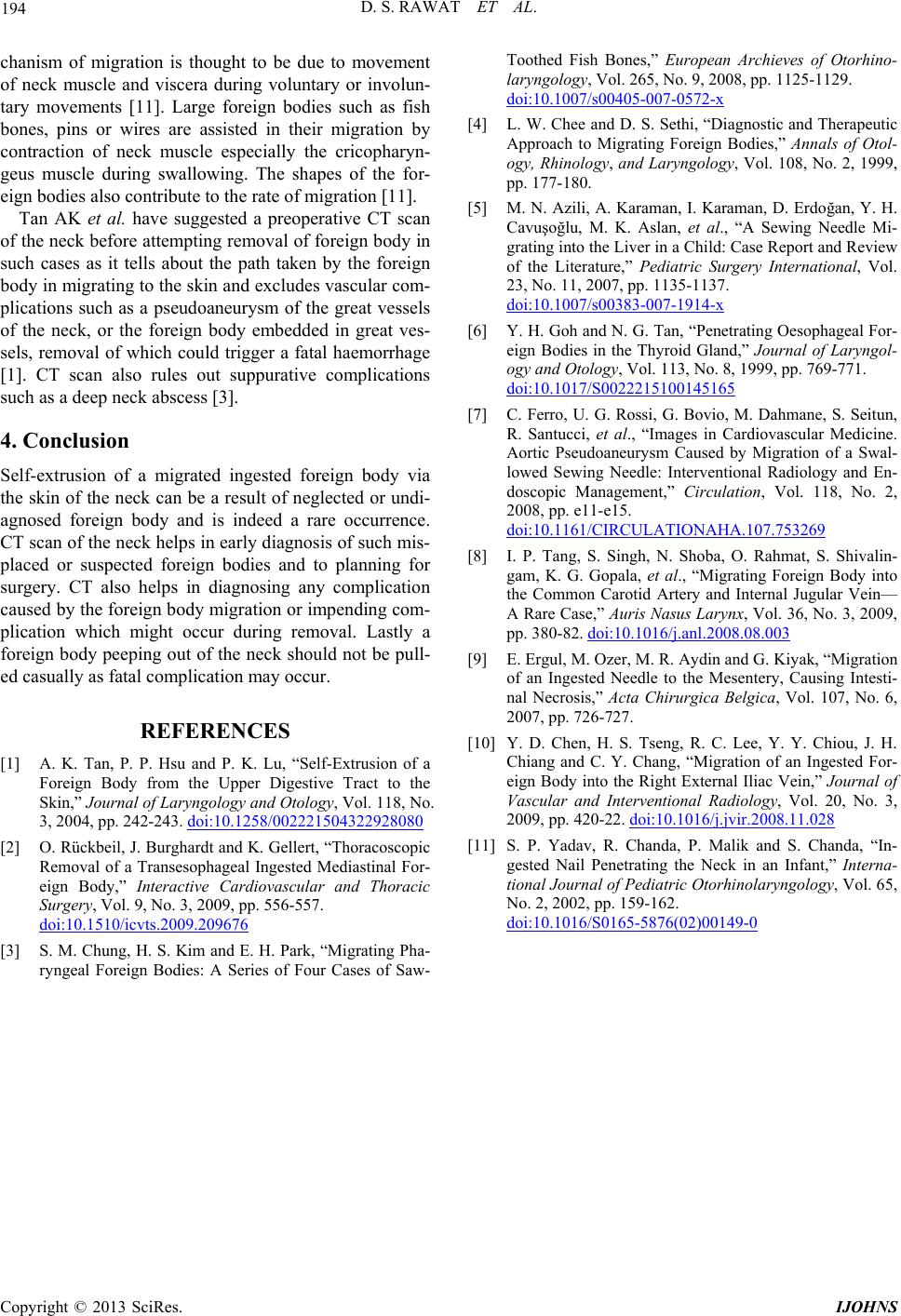
D. S. RAWAT ET AL.
Copyright © 2013 SciRes. IJOHNS
194
chanism of migration is thought to be due to movement
of neck muscle and viscera during voluntary or involun-
tary movements [11]. Large foreign bodies such as fish
bones, pins or wires are assisted in their migration by
contraction of neck muscle especially the cricopharyn-
geus muscle during swallowing. The shapes of the for-
eign bodies also contribute to the rate of migration [11].
Tan AK et al. have suggested a preoperative CT scan
of the neck before attempting removal of foreign body in
such cases as it tells about the path taken by the foreign
body in migrating to the skin and excludes vascular com-
plications such as a pseudoaneurysm of the great vessels
of the neck, or the foreign body embedded in great ves-
sels, removal of which could trigger a fatal haemorrhage
[1]. CT scan also rules out suppurative complications
such as a deep neck abscess [3].
4. Conclusion
Self-extrusion of a migrated ingested foreign body via
the skin of the neck can be a result of neglected or undi-
agnosed foreign body and is indeed a rare occurrence.
CT scan of the neck helps in early diagnosis of such mis-
placed or suspected foreign bodies and to planning for
surgery. CT also helps in diagnosing any complication
caused by the foreign body migration or impending com-
plication which might occur during removal. Lastly a
foreign body peeping out of the neck should not be pull-
ed casually as fatal complication may occur.
REFERENCES
[1] A. K. Tan, P. P. Hsu and P. K. Lu, “Self-Extrusion of a
Foreign Body from the Upper Digestive Tract to the
Skin,” Journal of Laryngology and Otology, Vol. 118, No.
3, 2004, pp. 242-243. doi:10.1258/002221504322928080
[2] O. Rückbeil, J. Burghardt and K. Gellert, “Thoracoscopic
Removal of a Transesophageal Ingested Mediastinal For-
eign Body,” Interactive Cardiovascular and Thoracic
Surgery, Vol. 9, No. 3, 2009, pp. 556-557.
doi:10.1510/icvts.2009.209676
[3] S. M. Chung, H. S. Kim and E. H. Park, “Migrating Pha-
ryngeal Foreign Bodies: A Series of Four Cases of Saw-
Toothed Fish Bones,” European Archieves of Otorhino-
laryngology, Vol. 265, No. 9, 2008, pp. 1125-1129.
doi:10.1007/s00405-007-0572-x
[4] L. W. Chee and D. S. Sethi, “Diagnostic and Therapeutic
Approach to Migrating Foreign Bodies,” Annals of Otol-
ogy, Rhinology, and Laryngology, Vol. 108, No. 2, 1999,
pp. 177-180.
[5] M. N. Azili, A. Karaman, I. Karaman, D. Erdoğan, Y. H.
Cavuşoğlu, M. K. Aslan, et al., “A Sewing Needle Mi-
grating into the Liver in a Child: Case Report and Review
of the Literature,” Pediatric Surgery International, Vol.
23, No. 11, 2007, pp. 1135-1137.
doi:10.1007/s00383-007-1914-x
[6] Y. H. Goh and N. G. Tan, “Penetrating Oesophageal For-
eign Bodies in the Thyroid Gland,” Journal of Laryngol-
ogy and Otology, Vol. 113, No. 8, 1999, pp. 769-771.
doi:10.1017/S0022215100145165
[7] C. Ferro, U. G. Rossi, G. Bovio, M. Dahmane, S. Seitun,
R. Santucci, et al., “Images in Cardiovascular Medicine.
Aortic Pseudoaneurysm Caused by Migration of a Swal-
lowed Sewing Needle: Interventional Radiology and En-
doscopic Management,” Circulation, Vol. 118, No. 2,
2008, pp. e11-e15.
doi:10.1161/CIRCULATIONAHA.107.753269
[8] I. P. Tang, S. Singh, N. Shoba, O. Rahmat, S. Shivalin-
gam, K. G. Gopala, et al., “Migrating Foreign Body into
the Common Carotid Artery and Internal Jugular Vein—
A Rare Case,” Auris Nasus Larynx, Vol. 36, No. 3, 2009,
pp. 380-82. doi:10.1016/j.anl.2008.08.003
[9] E. Ergul, M. Ozer, M. R. Aydin and G. Kiyak, “Migration
of an Ingested Needle to the Mesentery, Causing Intesti-
nal Necrosis,” Acta Chirurgica Belgica, Vol. 107, No. 6,
2007, pp. 726-727.
[10] Y. D. Chen, H. S. Tseng, R. C. Lee, Y. Y. Chiou, J. H.
Chiang and C. Y. Chang, “Migration of an Ingested For-
eign Body into the Right External Iliac Vein,” Journal of
Vascular and Interventional Radiology, Vol. 20, No. 3,
2009, pp. 420-22. doi:10.1016/j.jvir.2008.11.028
[11] S. P. Yadav, R. Chanda, P. Malik and S. Chanda, “In-
gested Nail Penetrating the Neck in an Infant,” Interna-
tional Journal of Pediatric Otorhinolaryngology, Vol. 65,
No. 2, 2002, pp. 159-162.
doi:10.1016/S0165-5876(02)00149-0